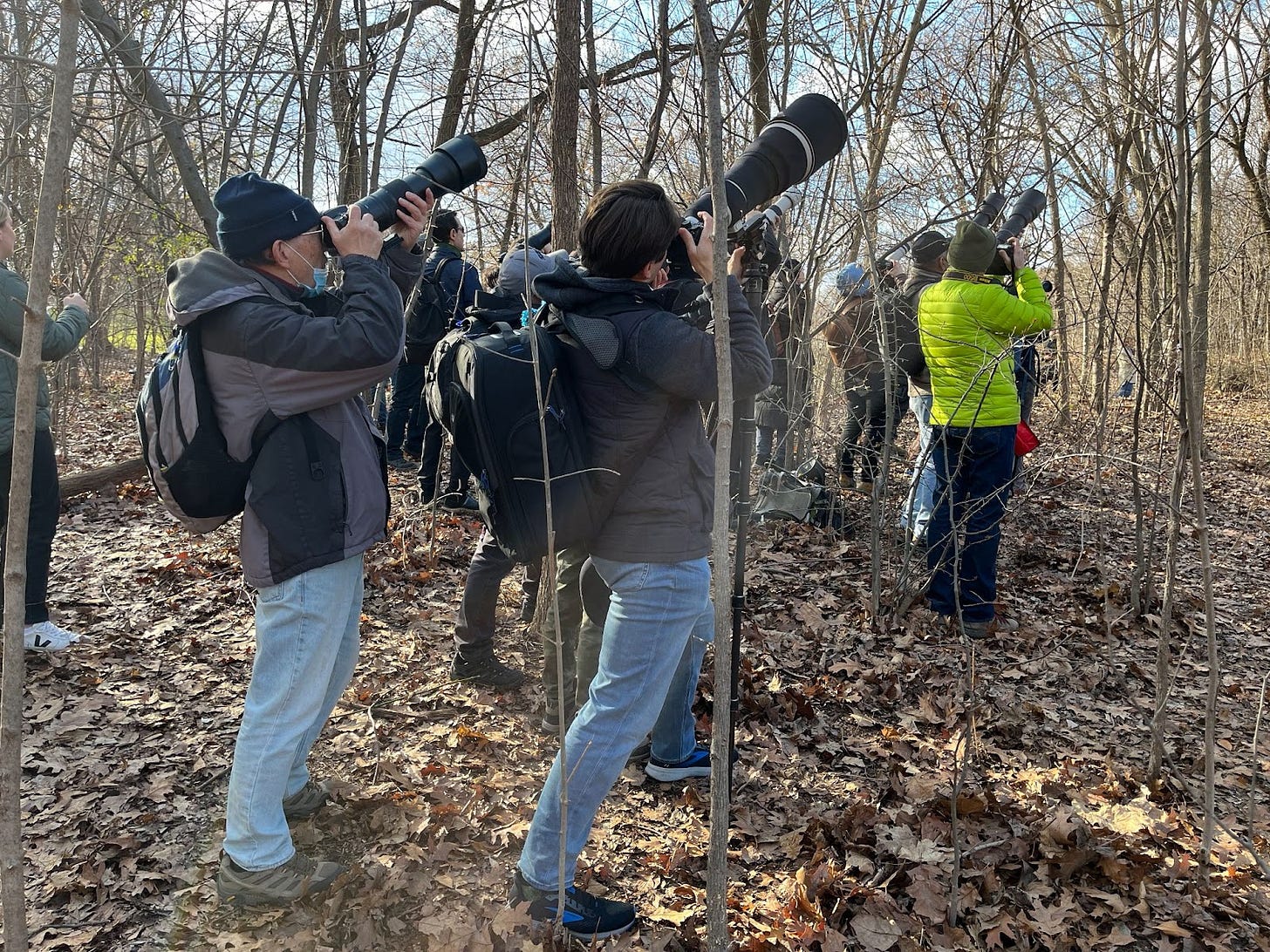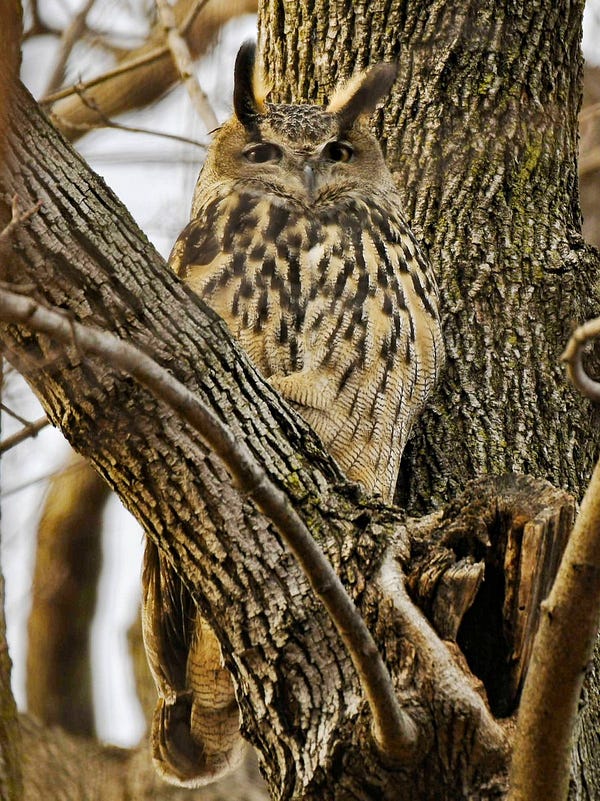Last Sunday, my brother and I met at 3pm sharp to take a train uptown. We’d learned through a niche Twitter fan network that New York’s latest It boy was currently making an appearance in Central Park, and we hoped to catch a glimpse. When we reached the park entrance, I punched in the coordinates of his reported location on my phone and guided us slowly towards the Great Hill. We thought it might take some searching, but the crowd surrounding him made him easy to spot. As we approached, we followed the line from their professional cameras and telephoto lenses to the trees where, wedged into a v-shaped branch like a luminescent baby cradled in god’s hands, was Flaco, a rotund eagle owl with two jaunty ear tufts, on the lam from Central Park Zoo, but at present, fast asleep. The crowd spoke in whispers to avoid waking him.

If you live in New York and are online, you’ve probably heard of Flaco. For the uninitiated: In 2010, an orange-eyed owlet was born in captivity in North Carolina, and was soon after moved to the Central Park Zoo, where he lived for 13 years until one month ago, when an unknown suspect vandalized the wire mesh surrounding his small habitat, inadvertently (or possibly in the spirit of vigilantism) cutting him loose. Falco flew uncertainly to freedom. The Wildlife Conservation Society took immediate action to bring him back to safety, enlisting the media to spread the word and help locate him. Their concern was well-founded: Flaco had never flown free in his life, nor hunted even once. Concern grew that, not understanding the city, let alone the wild, he would get hit by a car, or otherwise starve.




One of the first public Flaco sightings was on the sidewalk on Fifth Avenue, where he looked, as reporter Josh Nathan-Kazis described him, “wide and absent. A demented old man in a hospital gown, wandering the streets in search of a bar that closed in 1971.” The police were called, but all they managed was to snap a few photos before Flaco flew away. He spent his next days back in the park, closer to the zoo, where he was tracked intermittently before making his way to the North Meadow and North Woods, where he’s mostly stayed since then. In that time something interesting happened: Flaco started to fly more confidently, and within his first few days of freedom, and to his zookeepers’ surprise, he’d started hunting for the first time in his life. It was then that the tenor of the Flaco conversation began to shift from paternalistic concern to unbridled enthusiasm. Some fans created a Change.org petition to prevent his recapture. And after enough observation of Flaco’s progress, the zoo made an unusual decision: to let him be free.
It’s been one month and 10 days since his escape. Flaco appears to be living well, albeit a little unorthodoxly, opting to hunt almost exclusively at a construction site. I love the photos of him perched on Caterpillar equipment, an unconcerned fish out of water. His fanbase is thriving and democratic, with a different birder tweeting out his location every day so that others can come take a look (the thrill of finding him anew…can you imagine?). Anyone who manages to capture Flaco doing something cute—gazing outward with his ear tufts blown back, exhibiting calmness while besieged by crows, shuffling on a branch like a Broadway star—is showered with gratitude. People are voracious for updates on his foray into life as a wild owl. Is he getting enough food? Will he be okay when it snows? Is he lonely as the only Eurasian Eagle Owl in Central Park? Should he fuck the great horned owl Geraldine, who lives on Cedar Hill? Hopefully, hopefully, perhaps, probably.


I’ve been following Flaco’s great escape on Twitter for several weeks, with the emotional investment of Flaco’s own mother. I needed to see my son. My brother and I met at 3pm because we learned from @ManhattanBirdAlert, our prime Flaco resource, that he wakes up around 4:15pm (loved the specificity of that). Within about 20 minutes of joining the crowd below his Great Hill perch, he slowly opened his eyes, and we gasped. The camera shutters went off all at once, as if a celebrity had just stepped onto the red carpet. I stared into my binoculars, unable to believe what I was seeing. He looked like Totoro mixed with Pikachu. His body was a perfect plump oval, decorated by two dollar-coin eyes and the tiniest beak I’d ever seen. His feathery ear tufts stood erect, waving in the breeze. He was glamorous. Despite being awake, he didn’t move for a long time (who among us can’t relate). But whenever he turned his gaze downward, a photographer would announce firmly but quietly to the group, as if speaking into a wartime walkie talkie: “Looking down. Looking down. Beautiful. Eyes open.” So that everyone could get the shot. An unaccompanied boom mic was tied to a nearby tree, straining to catch a hoot.
Flaco’s cuteness, illustrating what Michiko Kakutani referred to as “baby schema” (round head, big eyes, roundish bod) in the New York Times, goes a long way to explain his popularity, but his story is undeniably iconic too. Some people, like Kakutani, suggest Flaco is an avatar for the liberatory promise of a post-pandemic world: We cheer him on because we ourselves want to be free, forever flung from the depths of quarantine, the wind whipping through our hair. But I think there’s something more elemental going on here. Something to do with the fact that Flaco was safe in an artificial environment, never asked to bet on his instincts, or court risk in exchange for the spoils of liberty, and now here he is, shakily navigating the big bad world, outperforming the lowly estimations of his closest caretakers, rewriting the rules of his own potential. It may be easier for a zookeeper to drop a dead rat on the bottom of your cage every day, but not necessarily preferable to hunting one yourself.
He’s the perfect local hero for a city like New York, full of nature-deprived dreamers, perennially torn between the promise of this place and the promise of leaving. I laughed imagining Flaco’s view of us city-people huddled below him. Did he wonder what we were doing, or why we were always there when he opened his eyes? Or was he used to that, as a once-unspecial exhibit at the Central Park Zoo? He reminds me a lot of my cat Bug (the resemblance is uncanny), and how often we joke about how he wouldn’t last a day on the streets. But who’s to say? Maybe he’s more capable than we imagine, maybe we all are. This is the mythic appeal of Flaco. He had no experience, no encouragement even, only an instinct towards freedom and no choice but to follow it. As Nathan-Kazis wrote of the night of his first escape: “That evening in early February was the first time in more than three decades that Flaco or any of Flaco’s ancestor-owls had spread their wings and flapped away.”


My favorite article I read last week was “Notes on Taste,” by Brie Wolfson for Are.na, a quasi-revival of Susan Sontag’s essay on camp which could have gone badly but didn’t. Friday’s 15 things also includes the ideal Instant-Pot comfort meal, a perfect movie scene, a "fitness test," and more. The Rec of the Week was favorite documentaries, inspired by a great one I saw last week. Excited to have a great list going now!
Thanks for reading and have a nice Sunday,
Haley







